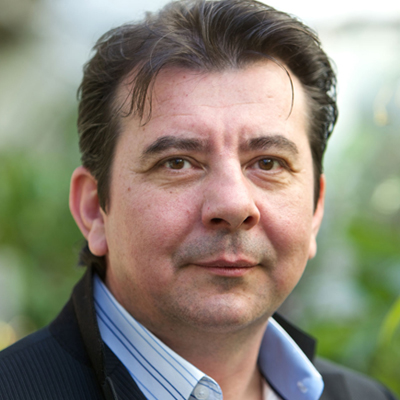Sustainable, cost-effective technologies improve health results
Nature has gifted us with remarkable living systems that can withstand extreme environments, perform intricate functions, and work collaboratively with other systems. Researchers are working to emulate nature’s “green” strategies for the production of new materials, devices, and therapies. Leading this effort is Dr. Francois Baneyx, of the University of Washington, who believes that “nothing beats the efficiency and economy of living systems.” While historically, his work has aimed to understand how proteins fold in the cell with a focus on the role of molecular chaperones, Dr. Baneyx and his team are now using these insights to dive deeper into the nascent field of bionanotechnology. For the last fifteen years, his group has investigated how proteins can be used to control the formation of complex inorganic structures that have extraordinary properties. Through a deepening understanding of such properties, Dr. Baneyx hopes to engineer materials and systems, inspired from nature’s designs, that will have an impact on medicine, electronics, physics, and more.
Dr. Baneyx’s research not only illuminates the exciting repertoire of tools that can be modeled after nature but has also helped to manufacture materials that are more efficient, cost effective, sustainable, and helpful. By engineering products from scratch, Dr. Baneyx and his team are able to harness the structure of a material in a way that helps people most. Dr. Baneyx argues that basic research is the most exciting thing a researcher can do because it gives the world the “ability to think about potential ways to apply fundamental knowledge to helping people.” As he and his team break new grounds, they also work towards applications that parallel the lab’s efforts. In fact, Dr. Baneyx’s latests projects have included the creation of nanovaccines, antibody-coated quantum dots, and the next generation of electronics components. In this way, he and his team are fostering creativity in order to make a difference for the future.
Current research includes:
-
Solid-Binding Peptides: Dr. Baneyx uses combinatorial techniques to isolate small peptides that bind to materials of engineering interest and studies why and how they bind. By inserting these peptides within functional proteins, Dr. Baneyx and his team are fabricating useful products including antibody-coated quantum dots and nanovaccines that may revolutionize how diseases are diagnosed and therapeutics are manufactured.
-
Complex Systems: Dr. Baneyx is exploring the use of chimaeric proteins to assemble and configure complex systems with nanoscale control of position. Such systems include what could be the electronics of the future and protonic circuits that will seamlessly interface with biology.
-
Protein Scaffolds: Dr. Baneyx and his collaborators are using computation to design entirely new protein scaffolds in order to achieve exquisite control of inorganic binding and templating for applications in medicine and catalysis.
Bio
Dr. Baneyx was first drawn to research because of his curiosity and the excitement he gets from true discovery. As a child, to the great sorrow of his mother, he spent his time taking apart small appliances and running chemistry experiments in an off-limit-to-adults portion of the backyard. Growing up, he realized that he liked chemistry and math equally which eventually drove him towards a chemical engineering degree. After moving from France to pursue his Ph.D. in Austin, TX, Dr. Baneyx was excited by the welcoming and creative culture of the US. As a Ph.D. student, Dr. Baneyx learned and became fascinated by biology and biotechnology; the combination of these interests led him to a faculty position. As a professor, Dr. Baneyx fosters a great deal of diversity within his group and his department because he believes that diversity helps to “bring little pieces of knowledge together that would otherwise go unnoticed.” He continues to find his work rewarding as he pieces together how things work and dreams up new ideas at the confluence of disciplines.
In his free time, aside from research, Dr. Baneyx enjoys working on his turn of the century craftsman bungalow, gardening and traveling with his family. In addition, he maintains an active lifestyle as you can find him hiking or kayaking whenever he gets a free moment. In college and as postdoc, Dr. Baneyx played student and division rugby, continuing to enjoy a sport he had learned in France while he settled into his new home in the US.
In the News
Publications
Videos
Awards
Fellow, American Association for the Advancement of Science (AAAS), 2013
Guest Editor: Biotechnology Journal Nanobiotechnology versus Bionanotechnology special issue, 2012
Conference co-chair: UEF Biochemical and Molecular Engineering XVII: Emerging Frontiers, 2011
UW College of Engineering Faculty Innovator Award: Research, 2010
Bill and Melinda Gates Foundation Grand Challenge Exploration Award, 2008
Patents
International Patent Application, pending: "Affinity tag and process for purification of recombinant proteins, silica surface functionalization, protein immobilization and controlled release."
Baneyx, F. and B.L. Coyle.
World Patent WO 94/23042: "A method for enhancing the production of biologically active recombinant proteins."
Baneyx, F., A.A. Gatenby and C.E. Kalbach.
U.S. Patent No. 5,552,301: "Process for enhancing the production of heterologous protein in biologically active conformation in a transformed E. coli dnaK mutant host cell."
Baneyx, F., A.A. Gatenby and C.E. Kalbach.
U.S. Patent No. 5,508,192: "Methods of producing proteolytically sensitive polypeptides."
Georgiou, G. and F. Baneyx.


